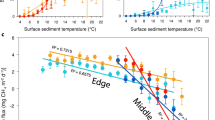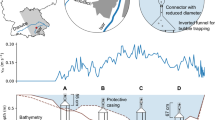Abstract
Lakes and ponds are important natural sources of the potent greenhouse gas methane (CH4), with small shallow waters identified as particular hotspots1,2. Ebullition (bubbles) of CH4 makes up a large proportion of total CH4 flux3,4. However, difficulty measuring such episodic events5 makes prediction of how ebullition responds to nutrient enrichment and rising temperatures challenging. Here, the world’s longest running, mesocosm-based, shallow lake climate change experiment was used to investigate how the combination of warming and eutrophication (that is, nutrient enrichment) affects CH4 ebullition. Eutrophication without heating increased the relative contribution of ebullition from 51% to 75%. More strikingly the combination of nutrient enrichment and experimental warming treatments of +2–3 °C and +4–5 °C had a synergistic effect, increasing mean annual ebullition by at least 1900 mg CH4-C m−2 yr−1. In contrast, diffusive flux showed no response to eutrophication and only a small increase at higher temperatures (average 63 mg CH4–C m−2 yr−1). As shallow lakes are the most common lake type globally, abundant in highly climate sensitive regions6 and most vulnerable to eutrophication, these results suggest their current and future contributions to atmospheric CH4 concentrations may be significantly underestimated.
This is a preview of subscription content, access via your institution
Access options
Access Nature and 54 other Nature Portfolio journals
Get Nature+, our best-value online-access subscription
$29.99 / 30 days
cancel any time
Subscribe to this journal
Receive 12 print issues and online access
$209.00 per year
only $17.42 per issue
Buy this article
- Purchase on Springer Link
- Instant access to full article PDF
Prices may be subject to local taxes which are calculated during checkout


Similar content being viewed by others
References
Holgerson, M. A. & Raymond, P. A. Large contribution to inland water CO2 and CH4 emissions from very small ponds. Nat. Geosci. 9, 222–226 (2016).
Tranvik, L. J. et al. Lakes and reservoirs as regulators of carbon cycling and climate. Limnol. Oceanogr. 54, 2298–2314 (2009).
Wik, M., Varner, R. K., Anthony, K. W., MacIntyre, S. & Bastviken, D. Climate-sensitive northern lakes and ponds are critical components of methane release. Nat. Geosci. 9, 99–105 (2016).
DelSontro, T., Boutet, L., St-Pierre, A., del Giorgio, P. A. & Prairie, Y. T. Methane ebullition and diffusion from northern ponds and lakes regulated by the interaction between temperature and system productivity. Limnol. Oceanogr. 61, S62–S77 (2016).
Wik, M., Thornton, B. F., Bastviken, D., Uhlbäck, J. & Crill, P. M. Biased sampling of methane release from northern lakes: A problem for extrapolation. Geophys. Res. Lett. 43, 1256–1262 (2016).
Verpoorter, C., Kutser, T., Seekell, D. A. & Tranvik, L. J. A global inventory of lakes based on high-resolution satellite imagery. Geophys. Res. Lett. 41, 6396–6402 (2014).
Bastviken, D., Tranvik, L. J., Downing, J. A., Crill, P. M. & Enrich-Prast, A. Freshwater methane emissions offset the continental carbon sink. Science 331, 50–50 (2011).
Kirschke, S. et al. Three decades of global methane sources and sinks. Nat. Geosci. 6, 813–823 (2013).
Saunois, M. et al. The global methane budget 2000–2012. Earth Syst. Sci. Data 8, 697–751 (2016).
Cole, J. et al. Plumbing the global carbon cycle: integrating inland waters into the terrestrial carbon budget. Ecosystems 10, 172–185 (2007).
Bastviken, D., Cole, J., Pace, M. & Tranvik, L. Methane emissions from lakes: Dependence of lake characteristics, two regional assessments, and a global estimate. Glob. Biogeochem. Cycles 18, GB4009 (2004).
Wilkinson, J., Maeck, A., Alshboul, Z. & Lorke, A. Continuous seasonal river ebullition measurements linked to sediment methane formation. Environ. Sci. Technol. 49, 13121–13129 (2015).
Wik, M. et al. Energy input is primary controller of methane bubbling in subarctic lakes. Geophys. Res. Lett. 41, 2013GL058510 (2014).
Moss, B., Kosten, S., Meerhoff, M. & Battarbee, R. W. Allied attack: climate change and eutrophication. Inland Waters 1, 101–105 (2011).
Yvon-Durocher, G. et al. Methane fluxes show consistent temperature dependence across microbial to ecosystem scales. Nature 507, 488–491 (2014).
Davidson, T. A. et al. Eutrophication effects on greenhouse gas fluxes from shallow-lake mesocosms override those of climate warming. Glob. Chang. Biol. 21, 4449–4463 (2015).
Deemer, B. R. et al. Greenhouse gas emissions from reservoir water surfaces: A new global synthesis. BioScience 66, 949–964 (2016).
Yvon-Durocher, G., Hulatt, C. J., Woodward, G. & Trimmer, M. Long-term warming amplifies shifts in the carbon cycle of experimental ponds. Nat. Clim. Chang. 7, 209–213 (2017).
Jeppesen, E., Søndergaard, M., Søndergaard, M. & Christoffersen, K. The Structuring Role of Submerged Macrophytes in Lakes (Springer-Verlag, New York, 1998).
West, W. E., Creamer, K. P. & Jones, S. E. Productivity and depth regulate lake contributions to atmospheric methane. Limnol. Oceanogr. 61, S51–S61 (2015). (S1).
Sanders, I. A. et al. Emission of methane from chalk streams has potential implications for agricultural practices. Freshw. Biol. 52, 1176–1186 (2007).
Dacey, J. W. H. & Klug, M. J. Methane efflux from lake sediments through Water Lilies. Science 203, 1253–1255 (1979).
Heilman, M. A. & Carlton, R. G. Methane oxidation associated with submersed vascular macrophytes and its impact on plant diffusive methane flux. Biogeochemistry 52, 207–224 (2001).
Yoshida, N., Iguchi, H. & Yurimoto, H. Aquatic plant surface as a niche for methanotrophs. Front. Microbiol. 5, 1–9 (2014).
Sayer, C. D., Davidson, T. A. & Jones, J. Seasonal dynamics of macrophytes and phytoplankton in shallow lakes: a eutrophication-driven pathway from plants to plankton? Freshw. Biol. 55, 500–513 (2010).
Vadeboncoeur, Y. et al. From Greenland to green lakes: Cultural eutrophication and the loss of benthic pathways in lakes. Limnol. Oceanogr. 48, 1408–1418 (2003).
Attermeyer, K. et al. Invasive floating macrophytes reduce greenhouse gas emissions from a small tropical lake. Sci. Rep. 6, 20424 (2016).
Krause-Jensen, D. & Duarte, C. M. Substantial role of macroalgae in marine carbon sequestration. Nat. Geosci. 9, 737–742 (2016).
West, W. E., Coloso, J. J. & Jones, S. E. Effects of algal and terrestrial carbon on methane production rates and methanogen community structure in a temperate lake sediment. Freshw. Biol. 57, 949–955 (2012).
Sorrell, B. K., Downes, M. T. & Stanger, C. L. Methanotrophic bacteria and their activity on submerged aquatic macrophytes. Aquat. Bot. 72, 107–119 (2002).
Jankowski, T., Livingstone, D. M. & Bührer, H. Consequences of the 2003 European heat wave for lake temperature profiles, thermal stability, and hypolimnetic oxygen depletion: Implications for a warmer world. Limnol. Oceanogr. 51, 815–819 (2006).
Bartosiewicz, M., Laurion, I., Clayer, F. & Maranger, R. Heat-wave effects on oxygen, nutrients, and phytoplankton can alter global warming potential of gases emitted from a small shallow lake. Environ. Sci. Technol. 50, 6267–6275 (2016).
IPCC Climate Change 2001: The Scientific Basis (eds Houghton, J. T. et al.) (Cambridge University Press, Cambridge, 2001).
Liboriussen, L. et al. Global warming: Design of a flow-through shallow lake mesocosm climate experiment. Limnol. Oceanogr.: Methods 3, 1–9 (2005).
Scheffer, M., Hosper, S. H., Meijer, M. L., Moss, B. & Jeppesen, E. Alternative equilibria in shallow lakes. Trends Ecol. Evol. 8, 275–279 (1993).
Raymond, P. A., Caraco, N. F. & Cole, J. J. Carbon dioxide concentration and atmospheric flux in the Hudson River. Estuaries 20, 381–390 (1997).
Wik, M., Crill, P. M., Varner, R. K. & Bastviken, D. Multiyear measurements of ebullitive methane flux from three subarctic lakes. J. Geophys. Res. Biogeosci. 118, 1307–1321 (2013).
Petersen, S. O. et al. Annual emissions of CH4 and N2O, and ecosystem respiration, from eight organic soils in Western Denmark managed by agriculture. Biogeosciences 9, 403–422 (2012).
Wiesenburg, D. A. & Guinasso, N.L. Equilibrium solubilities of methane, carbon monoxide, and hydrogen in water and sea water. J. Chem. Eng. Data 24, 356–360 (1979).
Gålfalk, M., Bastviken, D., Fredriksson, S. & Arneborg, L. Determination of the piston velocity for water-air interfaces using flux chambers, acoustic Doppler velocimetry, and IR imaging of the water surface. J. Geophys. Res. Biogeosci. 118, 770–782 (2013).
Jähne, B. et al. On the parameters influencing air-water gas exchange. J. Geophys. Res. Oceans 92, 1937–1949 (1987).
Liboriussen, L. et al. Effects of warming and nutrients on sediment community respiration in shallow lakes: an outdoor mesocosm experiment. Freshw. Biol. 56, 437–447 (2011).
Wanninkhof, R. Relationship between wind-speed and gas-exchange over the ocean. J. Geophys. Res. Oceans 97, 7373–7382 (1992).
Deacon, E. L. Sea-air gas transfer: The wind speed dependence. Bound. Layer. Meteorol. 21, 31–37 (1981).
Pinheiro, J., Bates, D., DebRoy, S., Sarkar, D. & R Core Team. nlme: Linear and Nonlinear Mixed Effects Models. R package v.3.1–131 (2014); https://CRAN.R-project.org/package=nlme
Zuur, A. F, Ieno, E. N, Walker, N, Saveliev, A. A. & Smith, G. M. Mixed Effects Models and Extensions in Ecology with R. (Springer New York, New York, 2009).
R Development Core Team R: a Language and Environment for Statistical Computing. (R Foundation for Statistical Computing, Vienna, Austria, 2011).
Maj, A. lmmfit: Goodness-of-fit-measures for linear mixed models with one-level-grouping. R package v.2.14 (2011).
Acknowledgements
The facility where this work was carried out was supported by the MARS (Managing Aquatic ecosystems and water Resources under multiple Stress) funded under the 7th EU Framework Programme, Theme 6 (Environment including Climate Change), Contract No. 603378 (http://www.mars-project.eu), AQUACOSM (Network of Leading European AQUAtic MesoCOSM Facilities Connecting Mountains to Oceans from the Arctic to the Mediterranean) and PROGNOS (Predicting in-lake RespOnses to chanGe using Near real time MOdelS- Water joint programme initiative) and ANAEE (anaee.dk). We would also like to thank the Carlsbergfondet for support to E.J. and T.A.D. J.A. was supported by FORMAS (grant 2015-1559), J.S. by the Marie Skłodowska-Curie fellowship (660655) and the Academy of Finland (project 296918). We are grateful to Dorte Nedergaard for the skilled GC analyses.
Author information
Authors and Affiliations
Contributions
T.A.D. designed the study, collected the data, analysed the data and wrote the manuscript. J.A. calculated the fluxes, E.J., J.A. and J.S. commented on the manuscript. F.L.A., T.L.L. and M.S. are key members of the group that supports the long-running mesocosm experiment.
Corresponding author
Ethics declarations
Competing interest
The authors declare no competing financial interests.
Additional information
Publisher’s note: Springer Nature remains neutral with regard to jurisdictional claims in published maps and institutional affiliations.
Supplementary information
Supplementary Information
Supplementary Figure 1
Rights and permissions
About this article
Cite this article
Davidson, T.A., Audet, J., Jeppesen, E. et al. Synergy between nutrients and warming enhances methane ebullition from experimental lakes. Nature Clim Change 8, 156–160 (2018). https://doi.org/10.1038/s41558-017-0063-z
Received:
Accepted:
Published:
Issue Date:
DOI: https://doi.org/10.1038/s41558-017-0063-z
This article is cited by
-
Global lakes are warming slower than surface air temperature due to accelerated evaporation
Nature Water (2023)
-
Challenges and opportunities in the use of ponds and pondscapes as Nature-based Solutions
Hydrobiologia (2023)
-
Temporarily and frequently occurring summer stratification and its effects on nutrient dynamics, greenhouse gas emission and fish habitat use: case study from Lake Ormstrup (Denmark)
Hydrobiologia (2023)
-
Greenhouse Gas Emissions from Agricultural Land Before and After Permanent Flooding with Seawater or Freshwater
Estuaries and Coasts (2023)
-
Mapping global lake dynamics reveals the emerging roles of small lakes
Nature Communications (2022)



